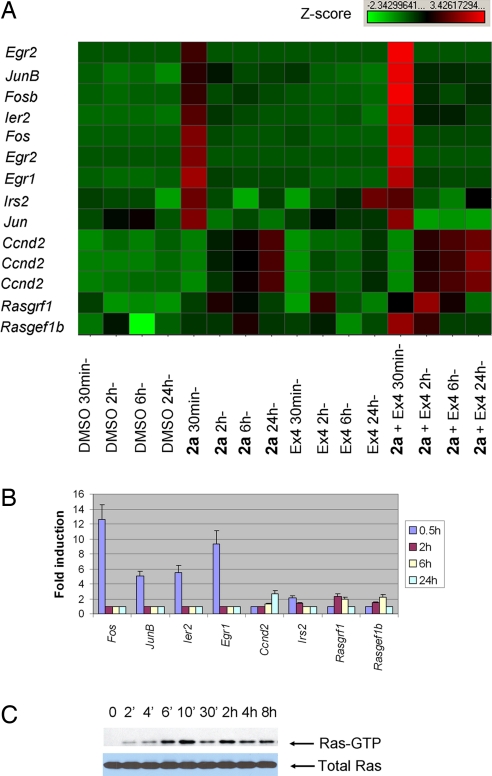Fig. 3.
Mechanistic studies of LTCC agonists. (A) Genes regulated by treatment with 2a (1 μM), the GLP-1 receptor agonist Exendin 4 (Ex-4, 5 nM), or both. Gene expression profiles were analyzed at 4 time points (30 min, 2 h, 6 h, and 24 h) after compound treatment of growth-arrested R7T1 β cells. Selected samples of differentially expressed genes are listed. Immediate-early response gene families, such as Fos, Jun, Egr, and Ier, were highly induced within 30 min after treatment with 2a. Irs2, a gene critical for β-cell survival and proliferation, was also up-regulated after treatment with 2a and Ex-4. Multiple entries for the same gene reflect multiple differentially expressed Affymetrix probe sets on the microarray. In addition, the expression of some RasGEFs was activated 2–6 h after treatment with 2a; this effect was enhanced by cotreating cells with Ex-4. Expression of Ccnd2 (cyclin D2) was up-regulated at 24 h after treatment with 2a; however, it too was up-regulated earlier (starting at 2 h posttreatment) and at higher levels after cotreatment with 2a and Ex-4. (B) The expression of several differentially expressed genes from microarray analysis was confirmed by real-time qRT-PCR. Growth-arrested R7T1 β cells were treated with 2a at the indicated time points; increases are relative to those found in DMSO-treated cells with each reaction performed in triplicate. (C) Activation of Ras signaling by 2a. Growth-arrested R7T1 β cells were treated with 2a at the indicated time points. Cell lysates were subjected to pull-down experiments by using the GST-Raf1 RBD fusion protein, followed by Western blot analysis to detect activated Ras (Ras-GTP, Upper); controls for Ras expression are also shown (total Ras, Lower).

